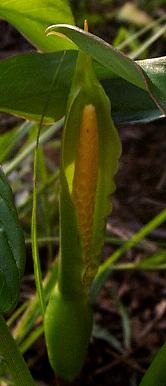![]()
![]()
![]()
Peltandra virginica - Tuckahoe, Green Arrow Arum, Arrow Leaf, Arrowleaf Arum
![]()
Use the 'back' button on your browser to return, if necessary.
|
|
FAMILY: DESCRIPTION: FLOWERS: HABITAT: | ||
|
OTHER INFORMATION: This hardy, aquatic perennial produces large, glossy dark green, arrow-shaped leaves annually from underground (and usually underwater) bulbs which are spiked with thick fibrous roots. The leaves can be anywhere from 3 - 8 inches wide and 4 - 30 inches long, and have three prominent veins, two of which 'point' backwards. It grows 1 to 2 feet high, though up north, larger plants occur. The native range of arrow arrum is from Maine to Ontario and Michigan, south to Florida, Louisiana, and Missouri - inhabiting the shallow waters of marshes, bogs, swamps, ditches and the margins of lakes, streams and rivers. It requires a wet lime-free, humus-rich soil in still or slowly flowing water less than 1 foot deep. While the seedlings need full sun, the mature plant can tolerate partial shade. It also tolerates a wide variety of soil pH and even a certain amount of salinity (up to 2 parts per thousand).
Arrow arrum grows in association with wetland shrubs and plants, wild rice, pickerelweed, woolgrass, burreeds, and soft rush. In shallower open water it is often by aggressive other rhizomotous species. A related species, Peltandra sagittaefolia (also known as White arrow arum or sometimes Spoonflower) is found only along the coastal areas of NC down to Florida and west to Mississippi. It bears red berries instead of black ones. Its flower has a white, rounded sheath around the spathe, hence the name Spoonflower, compared to the long green sheath in arrow arum.
KNOWN USES: In gardens, especially pond gardens, arrow arum is grown for it's decorative foliage and cover. It is also used in lake erosion control because the foliage and stems in large stands creates a wave deflecting or buffering barrier, while the root masses knit together and stabilize the submerged sediments. Arrow arrum fruit is a preferred food of wood ducks and is sometimes referred to as 'duck corn.' It is also eaten by muskrats and rails, but most other marsh birds and animals do not like them probably because of the calcium oxalate they contain. The foliage is seldom damaged, providing good cover to waterfowl, wading birds, insects, and aquatic mammals. The dried root was reportedly used by some American Indians as a flour for making bread, and the dried fruit were cooked like peas. The Nanticoke of Deleware prepared a mixture of grated root and milk which were given to babies for unknown purpose. In any case, the plant part must be thoroughly dried before eaten because it contains calcium oxalate crystals which causes a burning in the mouth. Cooking does not remove this property well, only complete drying. The root should be harvested in Fall or early Spring, and the fruit in late Summer to Fall.
THE NAME TUCKAHOE: Another name for this plant is Tuckahoe, and i've found interesting and conflicting reasons for this. Some maintain that Tuckahoe was a nickname (derived from native American word) for the lowlands of NC (then considered part of the territory of Virginia) and for the inhabitants of the area. It was also a name used for Powhatan Indians, and sometimes used to denote poor whites. Apparently, the settlers east of the Blue Ridge mountains were called Tuckahoe and the settlers west were referred to as Cowee. Early Appalachia Melungeons (mixed Indian and European) took English surnames and lived among the early Tuckahoes. Apparently in Algonquin the word meant 'round' or possibly 'tubular round dirty plant.' | |||
OFFSITE INFORMATION:
The Center for Aquatic Plants has another picture of the Arrowleaf Arum.
Several small pictures can be found at Ivy Creek Natural Area webpage.
No pictures, but a database of information is at the Plants for a Future website.
The USDA plant database has this info about arrowleaf Arum and a few pictures too.
Texas A&MU's site also has several pictures of this plant. Here, and here.
The Assateague Naturalist has several pictures and a short description of arrow arum.
![]()
